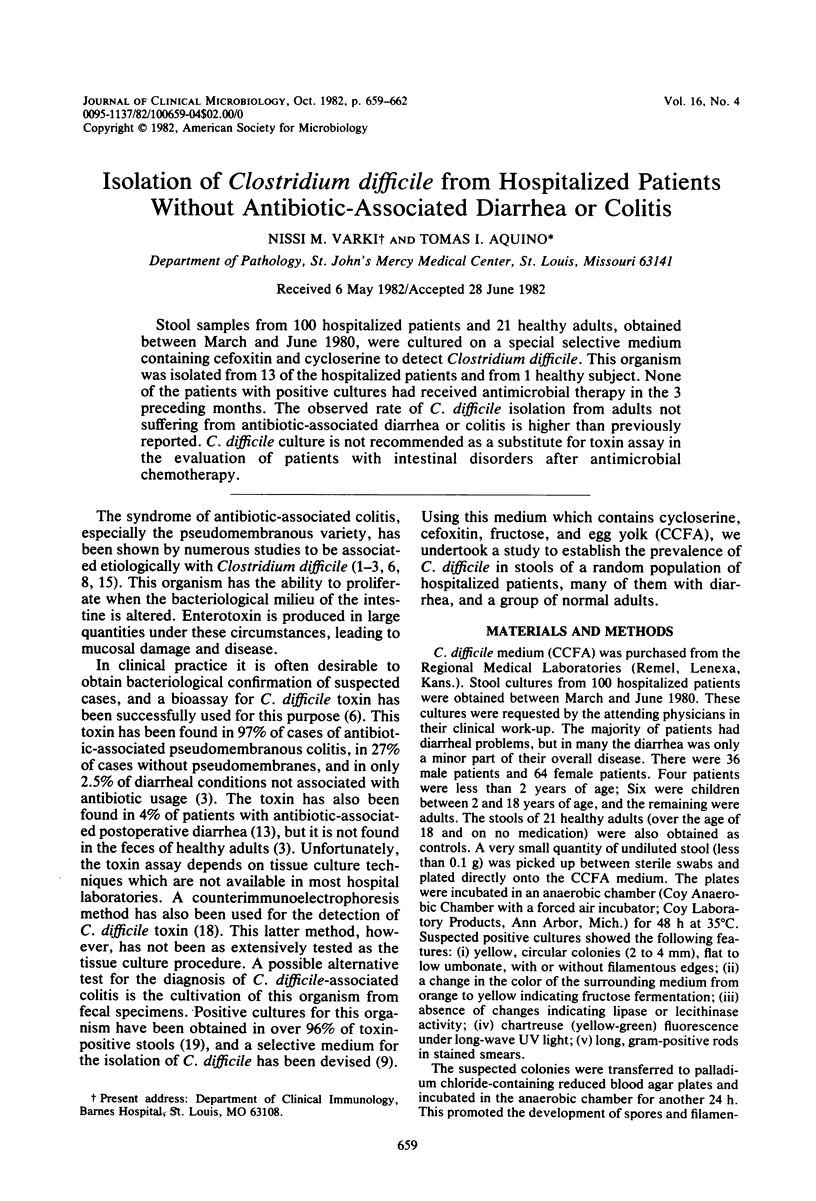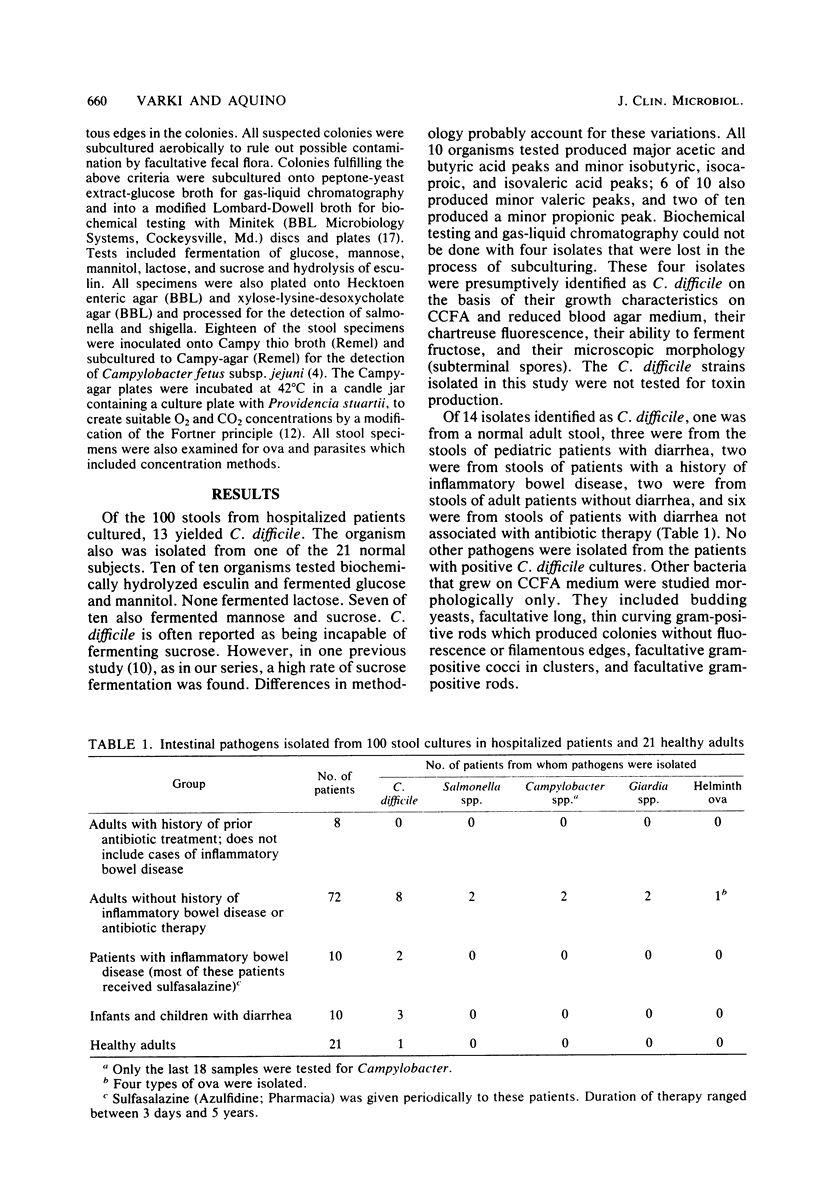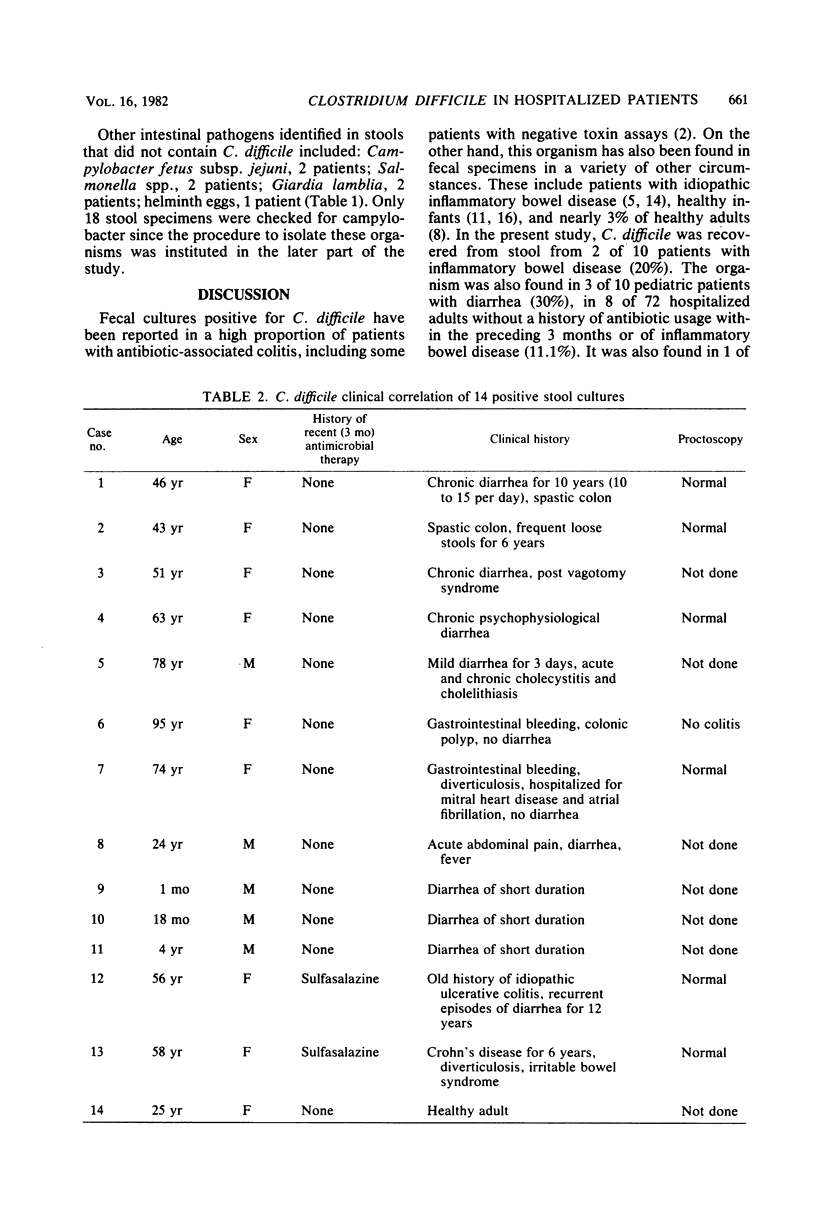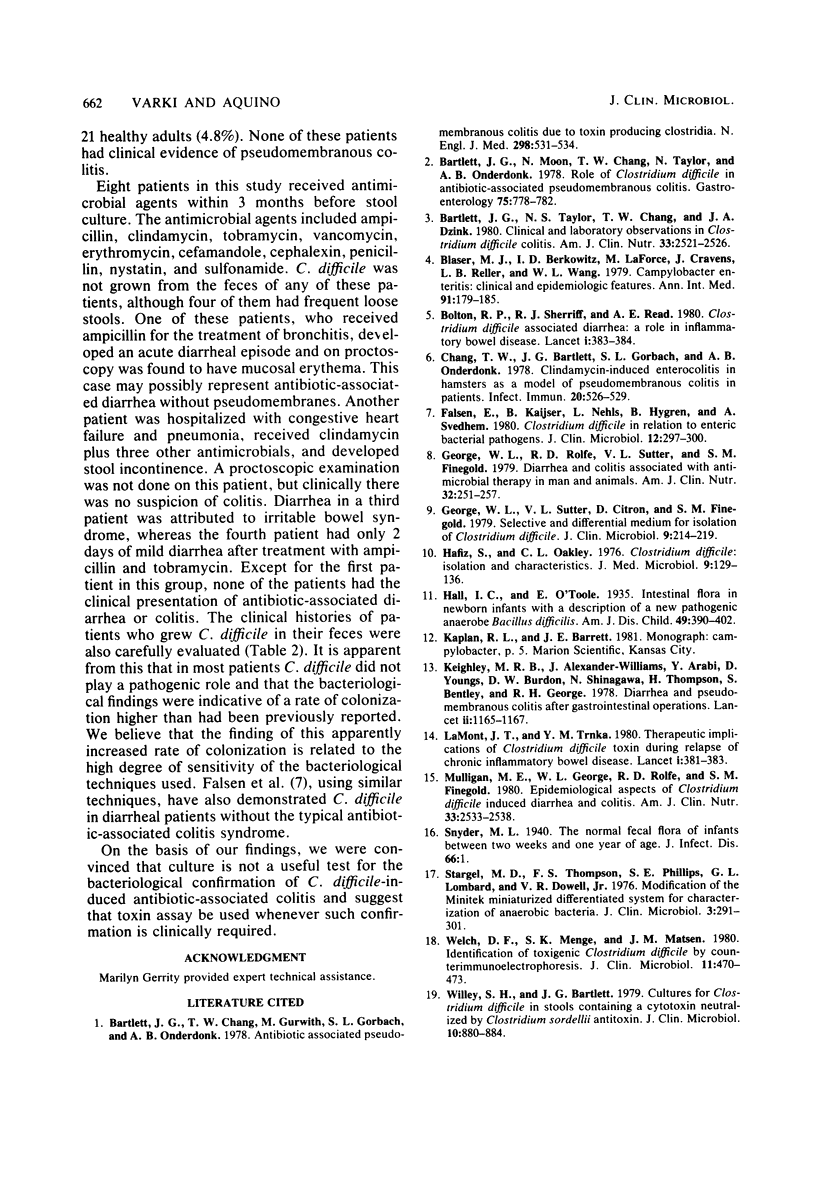Abstract
Stool samples from 100 hospitalized patients and 21 healthy adults, obtained between March and June 1980, were cultured on a special selective medium containing cefoxitin and cycloserine to detect Clostridium difficile. This organism was isolated from 13 of the hospitalized patients and from 1 healthy subject. None of the patients with positive cultures had received antimicrobial therapy in the 3 preceding months. The observed rate of C. difficile isolation from adults not suffering from antibiotic-associated diarrhea or colitis is higher than previously reported. C. difficile culture is not recommended as a substitute for toxin assay in the evaluation of patients with intestinal disorders after antimicrobial chemotherapy.
Full text
PDF



Selected References
These references are in PubMed. This may not be the complete list of references from this article.
- Bartlett J. G., Chang T. W., Gurwith M., Gorbach S. L., Onderdonk A. B. Antibiotic-associated pseudomembranous colitis due to toxin-producing clostridia. N Engl J Med. 1978 Mar 9;298(10):531–534. doi: 10.1056/NEJM197803092981003. [DOI] [PubMed] [Google Scholar]
- Bartlett J. G., Moon N., Chang T. W., Taylor N., Onderdonk A. B. Role of Clostridium difficile in antibiotic-associated pseudomembranous colitis. Gastroenterology. 1978 Nov;75(5):778–782. [PubMed] [Google Scholar]
- Bartlett J. G., Taylor N. S., Chang T., Dzink J. Clinical and laboratory observations in Clostridium difficile colitis. Am J Clin Nutr. 1980 Nov;33(11 Suppl):2521–2526. doi: 10.1093/ajcn/33.11.2521. [DOI] [PubMed] [Google Scholar]
- Blaser M. J., Berkowitz I. D., LaForce F. M., Cravens J., Reller L. B., Wang W. L. Campylobacter enteritis: clinical and epidemiologic features. Ann Intern Med. 1979 Aug;91(2):179–185. doi: 10.7326/0003-4819-91-2-179. [DOI] [PubMed] [Google Scholar]
- Bolton R. P., Sherriff R. J., Read A. E. Clostridium difficile associated diarrhoea: a role in inflammatory bowel disease? Lancet. 1980 Feb 23;1(8165):383–384. doi: 10.1016/s0140-6736(80)90940-x. [DOI] [PubMed] [Google Scholar]
- Chang T. W., Bartlett J. G., Gorbach S. L., Onderdonk A. B. Clindamycin-induced enterocolitis in hamsters as a model of pseudomembranous colitis in patients. Infect Immun. 1978 May;20(2):526–529. doi: 10.1128/iai.20.2.526-529.1978. [DOI] [PMC free article] [PubMed] [Google Scholar]
- Falsen E., Kaijser B., Nehls L., Nygren B., Svedhem A. Clostridium difficile in relation to enteric bacterial pathogens. J Clin Microbiol. 1980 Sep;12(3):297–300. doi: 10.1128/jcm.12.3.297-300.1980. [DOI] [PMC free article] [PubMed] [Google Scholar]
- George W. L., Rolfe R. D., Sutter V. L., Finegold S. M. Diarrhea and colitis associated with antimicrobial therapy in man and animals. Am J Clin Nutr. 1979 Jan;32(1):251–257. doi: 10.1093/ajcn/32.1.251. [DOI] [PubMed] [Google Scholar]
- George W. L., Sutter V. L., Citron D., Finegold S. M. Selective and differential medium for isolation of Clostridium difficile. J Clin Microbiol. 1979 Feb;9(2):214–219. doi: 10.1128/jcm.9.2.214-219.1979. [DOI] [PMC free article] [PubMed] [Google Scholar]
- Hafiz S., Oakley C. L. Clostridium difficile: isolation and characteristics. J Med Microbiol. 1976 May;9(2):129–136. doi: 10.1099/00222615-9-2-129. [DOI] [PubMed] [Google Scholar]
- Keighley M. R., Burdon D. W., Alexander-Williams J., Shinagawa N., Arabi Y., Thompson H., Youngs D., Bentley S., George R. H. Diarrhoea and pseudomembranous colitis after gastrointestinal operations. A prospective study. Lancet. 1978 Dec 2;2(8101):1165–1167. doi: 10.1016/s0140-6736(78)92151-7. [DOI] [PubMed] [Google Scholar]
- LaMont J. T., Trnka Y. M. Therapeutic implications of Clostridium difficile toxin during relapse of chronic inflammatory bowel disease. Lancet. 1980 Feb 23;1(8165):381–383. doi: 10.1016/s0140-6736(80)90939-3. [DOI] [PubMed] [Google Scholar]
- Mulligan M. E., George W. L., Rolfe R. D., Finegold S. M. Epidemiological aspects of Clostridium difficile-induced diarrhea and colitis. Am J Clin Nutr. 1980 Nov;33(11 Suppl):2533–2538. doi: 10.1093/ajcn/33.11.2533. [DOI] [PubMed] [Google Scholar]
- Stargel D., Thompson F. S., Phillips S. E., Lombard G. L., Dowell V. R., Jr Modification of the Minitek Miniaturized Differentiation System for characterization of anaerobic bacteria. J Clin Microbiol. 1976 Mar;3(3):291–301. doi: 10.1128/jcm.3.3.291-301.1976. [DOI] [PMC free article] [PubMed] [Google Scholar]
- Welch D. F., Menge S. K., Matsen J. M. Identification of toxigenic Clostridium difficile by counterimmunoelectrophoresis. J Clin Microbiol. 1980 May;11(5):470–473. doi: 10.1128/jcm.11.5.470-473.1980. [DOI] [PMC free article] [PubMed] [Google Scholar]
- Willey S. H., Bartlett J. G. Cultures for Clostridium difficile in stools containing a cytotoxin neutralized by Clostridium sordellii antitoxin. J Clin Microbiol. 1979 Dec;10(6):880–884. doi: 10.1128/jcm.10.6.880-884.1979. [DOI] [PMC free article] [PubMed] [Google Scholar]


